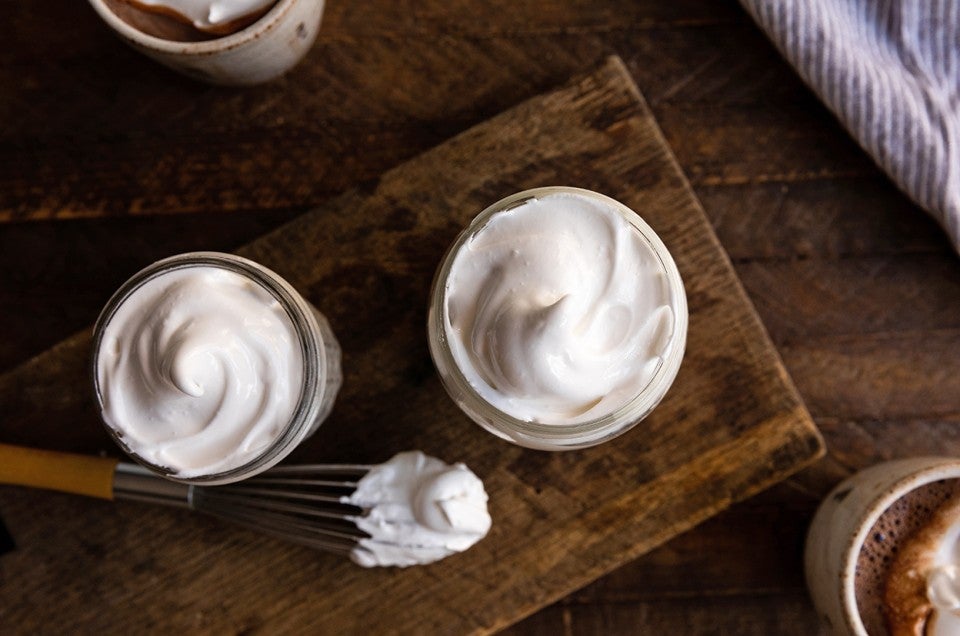


So, my friends, instead of telling stories or sharing jokes this time around, let's talk science. Specifically, let's talk a little bit about the science of simple sugar syrups and their effects on egg whites.
Oh, dear reader, please note that this is just the tip of the iceberg when it comes to egg and sugar science. Consider it just a lick and a promise to get you started.
As you probably know by now, marshmallow is basically egg whites, sugar, and air, plus maybe a little flavoring. Not very complicated ingredients, but definitely a confection that relies heavily on the reactions that happen when sugar is cooked rather than raw. Let's break it down a bit.
The structure of egg-based food and confections is based on the ability of the egg proteins to trap air in little bubbles and keep it there. Take scrambled eggs, for example. It's nothing more than whipping eggs with air and cooking it to solidify the egg proteins before those bubbles burst. Result? Fluffy light scrambled eggs. No whipping in of air? Fried eggs.
Now, if you've ever overcooked scrambled eggs, you'll know how tight and rubbery they get. What's up with that? When your delicate little egg proteins are heated, they begin to tighten up. The hotter they get, the tighter they get. Make them too hot and they become a dense, rubbery mess from which there is no return.
But we can use this tightening to our advantage with the use of a hot sugar syrup. It will sweeten our whipped egg whites AND help them tighten up enough to make sturdy bubbles that will grab together and provide great structure. One thing that adding hot syrup to egg whites will not do is cook them over the recommended safe temperature of 160°F. To be safe when using eggs that are raw or not fully cooked, use pasteurized eggs.
Get ready – here's how we're going to make Homemade Marshmallow Spread.
In a medium-sized heavy saucepan, combine 1/3 cup (74g) water, 3/4 cup (149g) sugar, and 3/4 cup (234g) corn syrup*. Bring to a boil and set a candy thermometer for 240°F.
The temperature will hover in the 220°F range for a long time, and then slowly creep up to the 230°F range. Once it reaches 230°F, it will go fairly quickly for the last 10 degrees.
*Honey can be used instead of the corn syrup; it works just fine.
When the sugar temperature reaches about 225°F, place 3 egg whites and 1/2 teaspoon cream of tartar in the bowl of your mixer. Start off at medium speed until you build up a foamy base, then increase the speed to high until the whites reach soft peaks.
By now the sugar syrup should be at 240°F. With the mixer running, slowly pour a steady stream of syrup along the inside of the bowl. The whites will deflate somewhat as the hot syrup hits, but keep whipping.
Remember, the hot syrup will heat the egg proteins. The proteins will begin to tighten up and a firmer structure will begin to develop. The structure will capture even more air than the whites alone, giving you billowy fluffy goodness.
Take good care as the bowl is quite hot at this stage. I borrowed my husband's handy dandy infrared thermometer to check the temperature. Sorry for the blur, but it's pretty darn hard to hold both this and the camera steady at one time.
Whip the spread for about 8 to 10 minutes, or until the it's thick and white and fluffy. The bowl will cool noticeably as well. When the spread is fairly well cooled, add 1 teaspoon vanilla and whip for another minute.
Pour the barely warm spread into an airtight bowl. Oh yes, it's a bit of a sticky job, but oh so fun!
I don't know about you, but I'm about ready for lunch. Care to split a sandwich?
Please make, rate, and review our recipe for Homemade Marshmallow Spread.








